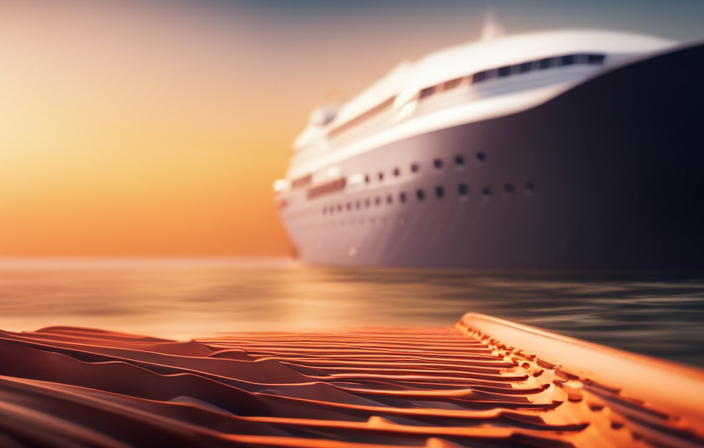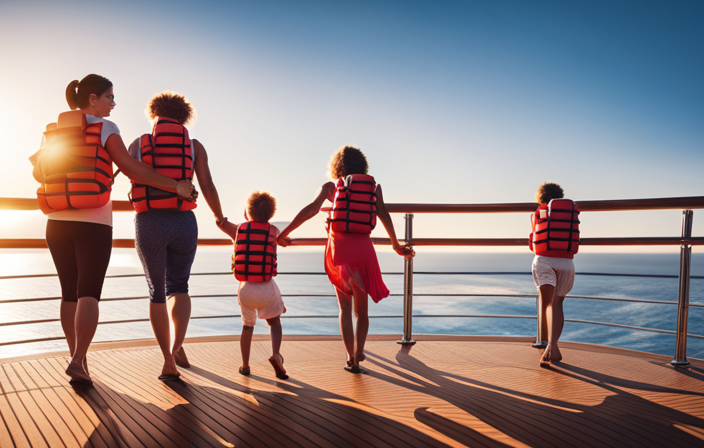What always amazes me about cruise ships is the incredible durability and toughness of their hulls. Fundamentally, the hull acts as the ship’s protective shield, securing it against the harsh elements of the sea and guaranteeing the safety of everyone on board, including both passengers and crew members.
But have you ever wondered just how thick these hulls are? Well, let me tell you, they are no ordinary walls. In fact, the thickness of a cruise ship’s hull can vary depending on a number of factors, such as the size of the ship and the materials used in its construction.
From my research, I’ve discovered some fascinating insights into the world of cruise ship hull design. So, join me as we dive deep into the world of hull thickness, exploring the importance, structure, and innovations that make these massive vessels so incredibly strong.
Key Takeaways
- The hull of a cruise ship is crucial for ensuring stability, safety, and structural integrity.
- The thickness of the hull varies based on the size of the ship, the materials used, and the intended operating conditions.
- The hull plays a significant role in passenger comfort by reducing motion, noise, and vibrations.
- Innovations in hull design focus on lighter and stronger materials, eco-friendly solutions, and advanced technologies for enhanced safety and performance.
The Importance of a Strong Hull in Cruise Ship Design
The robustness of a cruise ship’s hull is of utmost significance in ship design. The underwater hull design plays a critical role in ensuring stability and safety.
One key aspect is the hull’s impact resistance. It must withstand collisions with debris, icebergs, or accidental groundings.
To achieve this, high-strength materials like steel or aluminum are used in construction. The hull’s thickness varies based on ship size and purpose, typically between 25mm to 50mm.
This thickness provides necessary strength and structural integrity to withstand external forces and maintain the ship’s integrity.
Understanding the structure of a cruise ship’s hull is essential for comprehending its overall design and functionality.
Understanding the Structure of a Cruise Ship’s Hull
A cruise liner’s outer layer is constructed to withstand the immense pressure of the open ocean. It is engineered to protect the internal framework and ensure a smooth voyage for passengers. The structure of a cruise ship’s hull is carefully designed to provide both underwater corrosion resistance and impact resistance. Here are three key aspects of the hull’s structure:
-
Double hull construction: Many modern cruise ships feature a double hull design. This design provides an extra layer of protection against potential hull breaches. It helps minimize the risk of water ingress and strengthens the overall integrity of the hull.
-
Steel plating: The outer layer of the hull is typically made of thick steel plates. These plates are carefully welded together to form a seamless barrier that can withstand the forces of the ocean. The thickness of these plates can vary depending on the size and purpose of the ship.
-
Reinforced bulkheads: Inside the hull, reinforced bulkheads are strategically placed to provide additional strength and structural integrity. These bulkheads act as partitions, dividing the interior space and further enhancing the hull’s ability to withstand impacts.
Understanding the impressive thickness of a cruise ship’s hull, let’s delve into the specifics of its construction and materials.
The Impressive Thickness of a Cruise Ship’s Hull
Crafted with precision and engineered to withstand the immense pressure of the open ocean, a cruise liner’s outer layer is a testament to its remarkable thickness and strength. The underwater hull coatings play a crucial role in enhancing the impact resistance of cruise ship hulls. These coatings act as a protective barrier, shielding the hull from corrosion, fouling, and mechanical damage caused by floating debris or potential collisions. The thickness of a cruise ship’s hull can vary depending on various factors, including the ship’s size, intended use, and the materials used in its construction. It is typically measured in millimeters and can range from 25 mm to 100 mm or more. The thickness of the hull is carefully calculated to ensure the ship’s structural integrity and safety. Transitioning into the subsequent section, the factors that determine hull thickness are multifaceted and require careful consideration.
Factors That Determine Hull Thickness
There are several factors that determine the impressive thickness of a cruise liner’s outer layer. These factors directly impact the ship’s performance.
First, the size and weight of the ship are significant factors. Larger and heavier ships require thicker hulls to withstand the immense forces experienced at sea.
Second, the type of material used for construction affects hull thickness. Ships made of steel or aluminum typically have thicker hulls compared to those made of fiberglass or composite materials.
Third, the intended operating conditions also influence hull thickness. Ships that sail in rough seas or ice-infested waters require thicker hulls to provide greater protection against potential damage.
The hull thickness directly impacts the ship’s stability, buoyancy, and overall safety. It plays a vital role in ensuring passenger comfort by providing a stable and secure environment.
The Role of the Hull in Ensuring Passenger Comfort
The role of the hull in ensuring passenger comfort is crucial, as it directly impacts stability and smooth sailing.
A thick and sturdy hull helps to reduce the ship’s rolling and pitching motion, providing a more stable and comfortable ride for passengers.
Additionally, the hull plays a significant role in noise and vibration reduction, as it acts as a barrier against external disturbances, ensuring a quieter and more peaceful environment onboard.
Moreover, the hull provides protection against external elements such as waves, wind, and rain, ensuring the safety and comfort of passengers even in challenging weather conditions.
Stability and Smooth Sailing
Imagine yourself on a cruise ship, feeling the gentle sway of the ocean beneath you as you marvel at the stability and smooth sailing, all thanks to the carefully engineered hull that keeps you safe and comfortable.
The stability of a cruise ship is achieved through the design and construction of its hull, which is optimized for hydrodynamics. The hull is designed to minimize resistance and enhance stability by utilizing advanced techniques such as bulbous bows and stabilizing fins. These features reduce the ship’s tendency to roll and pitch, ensuring a smooth ride even in rough seas.
Additionally, the hull’s shape and thickness are carefully calculated to withstand the forces exerted by the water and maintain stability.
As we move into the next section about noise and vibration reduction, it is important to understand how the hull design contributes to overall passenger comfort.
Noise and Vibration Reduction
As you relax on your ocean voyage, you’ll appreciate the blissful silence and absence of vibrations, thanks to the innovative noise and vibration reduction technology implemented throughout the vessel.
-
Acoustic Insulation: The cruise ship’s hull is equipped with specialized materials that absorb and dampen noise, preventing it from reaching the interior spaces.
-
Vibration Dampers: Strategically placed dampers counteract vibrations generated by the ship’s engines and external forces, ensuring a smooth and comfortable ride.
-
Structural Enhancements: The hull design incorporates stiffness and rigidity to minimize resonant vibrations, reducing noise and enhancing passenger comfort.
-
Engine Room Isolation: Advanced isolation techniques isolate the engine room, reducing noise and vibrations from the ship’s machinery.
-
Anti-Noise Measures: Active noise cancellation systems are employed in certain areas to further reduce ambient noise levels.
With noise and vibration effectively controlled, the cruise ship provides a serene environment for passengers to enjoy their voyage.
Moving forward, let’s explore the next section about the ship’s protection against external elements.
Protection Against External Elements
Stay worry-free as you sail through the ocean, knowing that the vessel is equipped to withstand the harshest external elements and protect you from any potential discomfort. Cruise ships are built with a strong hull that provides exceptional protection and durability. The hull is the outermost layer of the ship’s structure, designed to shield the interior from water, wind, and other external forces. It is typically made of steel, which offers superior strength and resistance to corrosion. To give you a clearer picture, here is a table that outlines the thickness of different parts of a cruise ship’s hull:
| Hull Component | Thickness (inches) |
|---|---|
| Outer plating | 0.75 |
| Shell plating | 0.5 |
| Bulkhead | 0.5 |
| Keel | 1.0 |
| Decks | 0.625 |
These measurements ensure the ship’s structural integrity and provide optimal protection against external elements. Now, let’s delve into the testing and certification processes for cruise ship hulls.
Testing and Certification Processes for Cruise Ship Hulls
When it comes to ensuring the safety and reliability of cruise ship hulls, there are several key factors to consider.
Non-destructive testing methods play a crucial role in evaluating the integrity of the hull structure without causing any damage.
Additionally, classification societies play a vital role in setting and enforcing certification standards that ensure cruise ships meet specific safety criteria.
These processes are essential for maintaining the highest levels of safety and comfort for passengers on board cruise ships.
Non-Destructive Testing Methods
The non-destructive testing methods reveal the hull’s thickness, allowing us to peer into its structural integrity like a skilled surgeon with an X-ray machine. Using advanced non-destructive testing techniques, such as ultrasonic thickness measurement, we can accurately determine the thickness of the cruise ship’s hull.
This method involves sending ultrasonic waves into the hull and measuring the time it takes for the waves to bounce back. By analyzing the data, we can determine the thickness of the hull at various points. This information is crucial in assessing the ship’s overall strength and durability. It helps us identify any potential weak areas that may require reinforcement or repair.
The non-destructive testing methods provide us with valuable insights into the hull’s condition, ensuring that it meets the rigorous standards set by classification societies and certification standards, guaranteeing the safety of passengers and crew.
Classification Societies and Certification Standards
Classification societies and certification standards play a crucial role in ensuring the safety and reliability of passenger vessels. These societies, such as Lloyd’s Register and DNV GL, set the classification society standards that cruise ship manufacturers must adhere to during hull construction.
These standards cover various aspects of hull design and construction, including materials, structural integrity, and safety features. Additionally, certification standards ensure that the hull meets specific criteria for strength, stability, and resistance to various environmental conditions.
To meet these standards, cruise ship manufacturers employ advanced hull construction techniques, such as welding and steel fabrication, to create a strong and durable hull. These techniques are continuously evolving to improve the structural integrity and safety of cruise ships.
This focus on innovation in hull construction leads us to the next section about innovations in cruise ship hull design.
Innovations in Cruise Ship Hull Design
Experience the revolutionary innovations in cruise ship hull design. You’ll be amazed by the remarkable thickness of the hull that ensures the safety and stability of your luxurious voyage. These cutting-edge hull designs have been developed with a focus on passenger comfort and have resulted in significant advancements in the industry.
One notable innovation is the use of advanced materials, such as high-strength steel and composite materials. These materials provide enhanced strength and durability while reducing the overall weight of the hull.
Additionally, innovative hull shapes and designs have been implemented to improve hydrodynamics and reduce drag. This results in increased fuel efficiency and reduced environmental impact.
These advancements in cruise ship hull design have truly revolutionized the industry. Passengers now enjoy a safer, more comfortable, and environmentally friendly voyage.
Now, let’s delve into the case studies of noteworthy cruise ship hulls. We will explore the incredible engineering feats that have been achieved.
Case Studies of Noteworthy Cruise Ship Hulls
When it comes to cruise ship hulls, there are a few noteworthy examples that stand out.
First, the largest and most technologically advanced hulls are a marvel of engineering. These massive structures are designed to withstand the immense pressures of the open ocean while providing a stable and comfortable environment for passengers.
Second, there are historic and iconic cruise ship hulls that have become famous for their design and elegance. These vessels have left a lasting impact on the industry and continue to inspire future innovations.
Largest and Most Technologically Advanced Hulls
The largest and most technologically advanced cruise ship hulls are truly impressive in terms of their thickness. These engineering marvels are built to withstand the forces of the ocean while providing a stable and comfortable experience for passengers on board. Here are four key features of these remarkable hulls:
-
Extreme Thickness: The hulls of these ships can be up to 1 inch thick, made from high-strength steel to ensure structural integrity and protect against potential damage from icebergs or rough seas.
-
Advanced Composite Materials: Some of the most advanced hulls incorporate composite materials, such as carbon fiber reinforced polymers, which offer an excellent strength-to-weight ratio and corrosion resistance.
-
Reinforced Bulkheads: These hulls are equipped with reinforced bulkheads, dividing the ship into separate compartments to enhance stability and safety. The bulkheads are often made of steel plates, providing additional protection against flooding.
-
State-of-the-Art Coating Systems: To prevent corrosion and marine growth, these hulls are coated with advanced paint systems specifically designed for the harsh marine environment.
As we transition into the next section about historic and iconic cruise ship hulls, it is fascinating to consider how far hull technology has come in recent years.
Historic and Iconic Cruise Ship Hulls
Stepping back in time, it’s fascinating to see the iconic and historic hulls that have graced the seas. These magnificent vessels, meticulously preserved for their historical significance, showcase the remarkable craftsmanship and iconic designs of bygone eras.
From the majestic Titanic, with its distinct black hull and riveted steel plates, to the elegant Queen Mary, with its sleek lines and graceful curves, these ships evoke a sense of nostalgia and admiration.
Each hull tells a unique story, representing a time when ocean travel was a luxurious and grand affair.
As we delve into the maintenance and inspection of cruise ship hulls, we can learn valuable lessons from the past, ensuring that these iconic designs endure for future generations to appreciate.
Maintenance and Inspection of Cruise Ship Hulls
The maintenance and inspection of cruise ship hulls involves regular checks to ensure their thickness remains within acceptable limits. An interesting statistic is that the average thickness of a cruise ship hull is around 30 millimeters.
To maintain the integrity of the hull, various maintenance techniques are employed. These include underwater cleaning, painting, and cathodic protection. These measures help prevent common hull problems such as corrosion, biofouling, and cracks.
Regular inspections are done using ultrasonic thickness gauges. These gauges measure the thickness of the hull plates and identify any areas of concern. If any thickness reduction is detected, repairs are carried out promptly to ensure the structural integrity of the hull.
Looking ahead, advancements in hull design aim to enhance performance, fuel efficiency, and environmental sustainability. These advancements will still maintain the necessary strength and thickness of the hull.
The Future of Cruise Ship Hull Design
To stay ahead in the evolving world of cruise ship design, engineers are constantly brainstorming innovative ways to enhance performance and efficiency while ensuring the necessary strength and integrity of the vessel’s outer structure.
In terms of the future of cruise ship hull design, there are several exciting innovations on the horizon. One of the key areas of focus is the development of eco-friendly materials that can be used to construct the hull. These materials aim to reduce the environmental impact of cruise ships by minimizing carbon emissions and waste generation.
Additionally, future hull designs may incorporate advanced technologies such as self-healing materials, which would allow for easier maintenance and repair. Another area of interest is the use of lightweight materials that can improve fuel efficiency and increase the ship’s speed.
These advancements in hull design hold great promise for the future of the cruise industry.
Frequently Asked Questions
Can passengers feel the movement of the ship through the hull?
Passengers can feel slight hull vibrations caused by the ship’s movement, but they are usually minimal and not bothersome. The hull’s noise insulation is effective in reducing engine and wave noise, ensuring a peaceful experience onboard.
How does the hull thickness affect the ship’s stability in rough seas?
The hull thickness of a cruise ship has a significant impact on its stability in rough seas. A thicker hull provides greater stability, which enhances passenger comfort and reduces the ship’s fuel efficiency.
Are there any specific regulations or standards regarding hull thickness for cruise ships?
There are regulations and standards in place for hull thickness on cruise ships. These guidelines ensure the structural integrity and safety of the vessel. Compliance with these regulations is crucial to maintain the ship’s stability and withstand rough seas.
What materials are commonly used for cruise ship hulls?
Cruise ship hulls are commonly made of steel or aluminum. Steel offers strength, durability, and resistance to impact. However, it is heavier and requires more maintenance. Aluminum is lightweight, corrosion-resistant, but less durable.
How often do cruise ship hulls need to be inspected and maintained?
Inspecting cruise ship hulls regularly is crucial for their longevity. A tiny crack in the hull can lead to catastrophic consequences. Maintenance is vital to prevent costly repairs and extend the ship’s lifespan.
Conclusion
In conclusion, the thickness of a cruise ship’s hull is of paramount importance in ensuring the safety and comfort of passengers. The hull acts as the protective barrier against the harsh elements of the sea, and its strength is crucial in withstanding the forces exerted on the ship.
Through innovative design and cutting-edge materials, cruise ship hulls have become increasingly sturdy and reliable. Regular maintenance and inspection are also essential to identify any potential issues and ensure the longevity of the hull.
As technology continues to advance, we can expect even more impressive developments in cruise ship hull design in the future.










